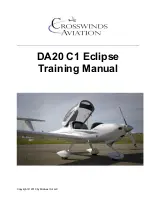
www.apcoaviation.com
16
FIRST FLIGHTS
In order to get familiar with your wing we recommend flying with trimmers at
the
0
position
first in stable non-turbulent weather.
Once you feel confident with your wing, you can start experimenting with faster trim settings and speed system, taking all necessary
precautions. Learn to use all of the additional speed of the F3.
Remember
: do not exceed the envelope of weather, wing and other parameters to insure safe flying.
INFLATION
Check wind direction, even when it seems that there is no wind at all, there is always some drift.
Therefore, be careful in determining the conditions, since in PPG flying it is most important that the launch and initial climb are
performed with a head wind (the danger of losing your airspeed while crossing the wind gradient is greatly reduced).
Special attention must be paid to trees, power lines and other obstacles, including the possibility of emerging rotors.
Launch preparation
Lay out the paraglider in an arc, downwind of the power unit, with all suspension lines taut and pointing toward center of the power unit.
The risers are to be laid on the ground.
Set the trimmers in 0 positions.
Make sure that you warm up the engine while standing windward of the wing. Stop the engine before clipping in the risers.
Now have quick checks if:
•
Helmet is on and fastened.
•
The risers are clipped into the carabiners.
•
The trimmers are properly set.
•
Propeller is clear.
•
Speed system is functioning, problem free.
•
Steering lines and handles are free and not twisted.
•
The engine delivers full power.
•
Take off area is clear of approaching traffic, obstacles and free to use.
When you are sure all is OK, you can clip in the wing and execute launch as described in paragraph 17.2.
From now on you should steer / handle the paraglider facing forward, without looking back over your shoulder. If the wing is retreating
and behind you at a low angle, do not turn around as there is a danger of falling on your back and damaging the propeller and catching
lines in the propeller, so it should be avoided.
During take-off, when you feel the tension on both risers to be equal, make sure the
wing
is overhead, open up full power and lean back












































